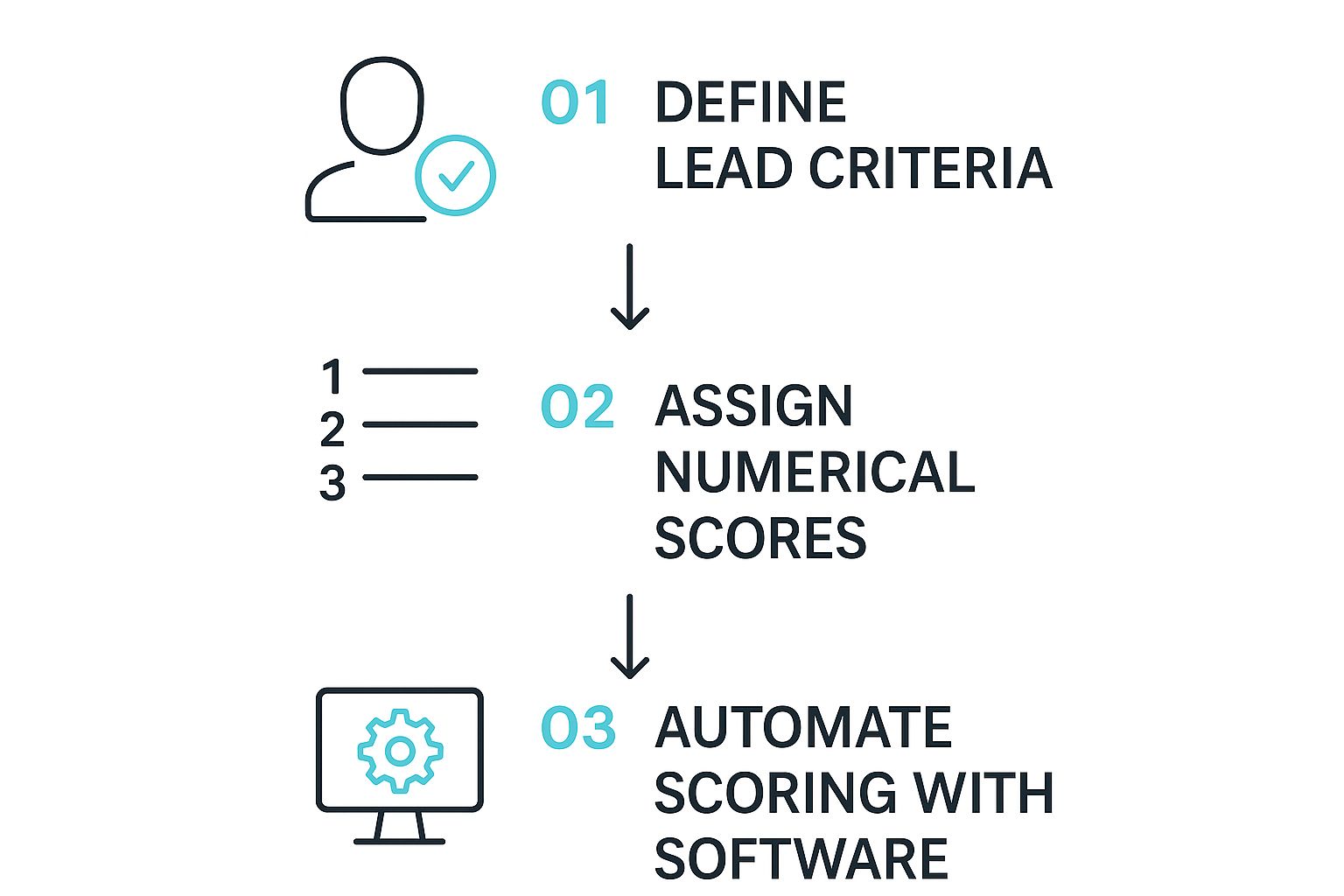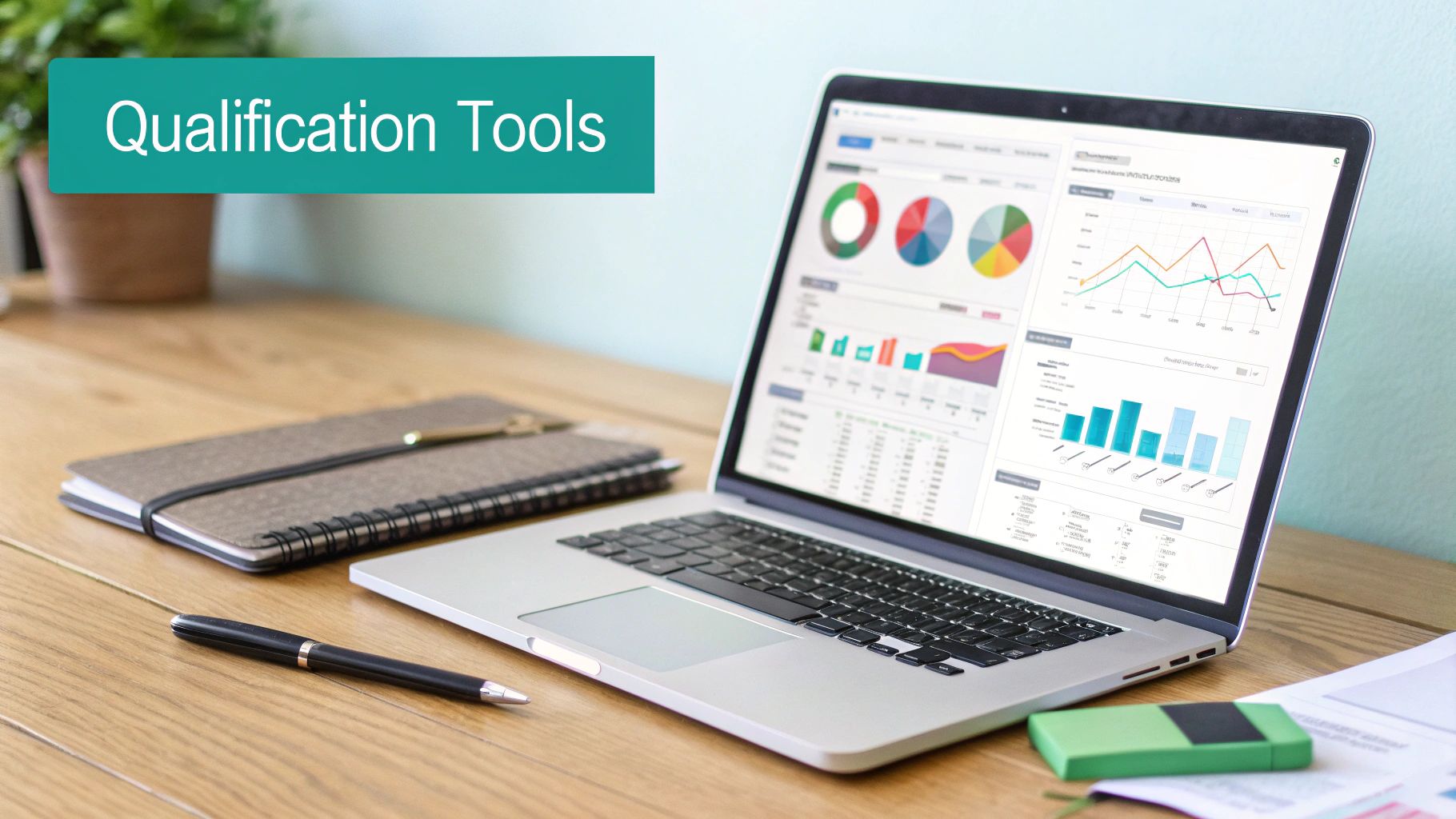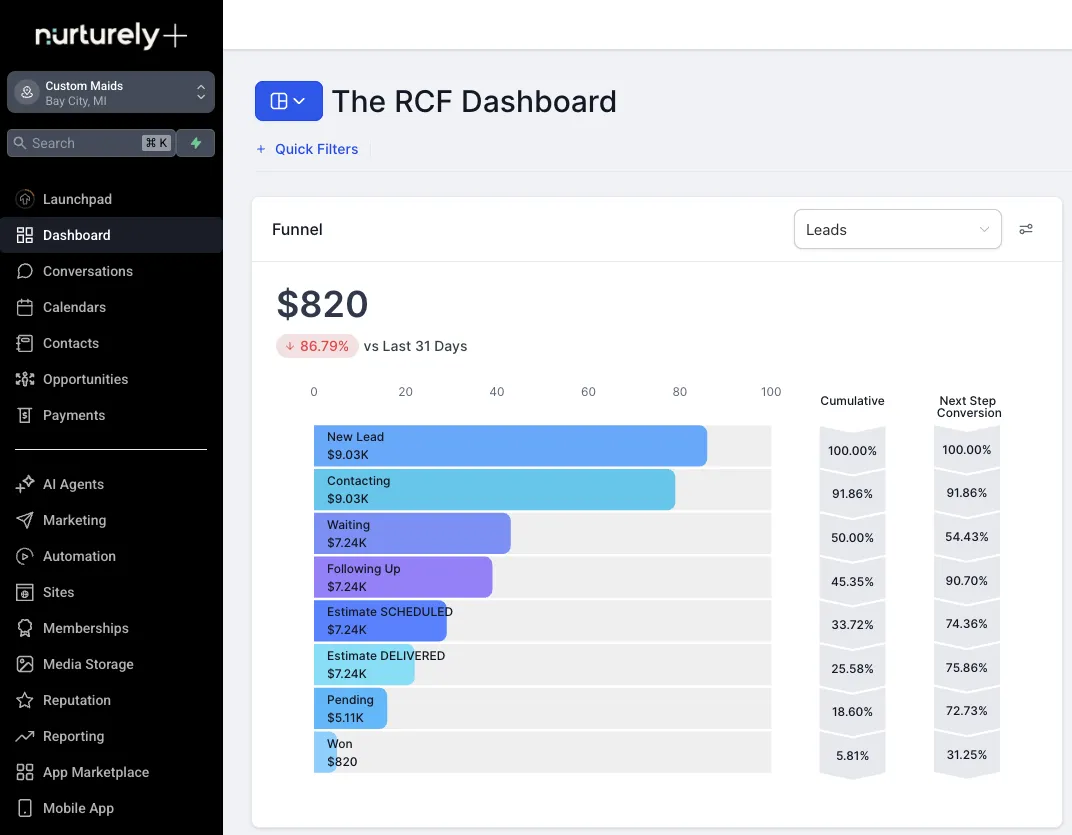Lead Qualification Process
A Modern Lead Qualification Process That Closes Deals
Let's be real for a minute. A cluttered sales pipeline isn't a sign that business is booming—it's a symptom of a broken process. When you have an outdated lead qualification process, your team ends up wasting precious time chasing down prospects who were never going to buy in the first place. That inefficiency costs you. It leads directly to lost revenue, plummeting team morale, and stalled growth.
Why Your Old Lead Qualification Process Is Costing You Money

Too many businesses fall into the trap of thinking that more leads automatically equals more sales. In my experience, the opposite is often true. A pipeline packed with unqualified prospects is a massive drain on your resources. Your sales reps burn through their days calling contacts who don't have the budget, the authority, or even a genuine need for what you're selling. It's a recipe for frustration and burnout.
This isn't just a "vibe" thing; it has a tangible cost. When your team is forced to prioritize quantity over quality, a few things inevitably happen:
Wasted Sales Efforts: Every hour spent on a dead-end lead is an hour you could have invested in a high-potential one.
Inaccurate Forecasting: How can you possibly predict revenue when your pipeline is full of fluff? It's impossible.
Lower Conversion Rates: Spreading your team's energy too thin means the genuinely good leads don't get the focus they deserve to convert.
Decreased Team Morale: Facing constant rejection from poorly matched prospects will demoralize even your most resilient sales pros.
The Real Cost of Guesswork
So what's the difference between a team that has a process and one that's just winging it? It's night and day. Without clear criteria, your sales team is essentially guessing which leads to focus on. That guessing game is expensive, leading to longer sales cycles as genuinely interested buyers slip through the cracks. If you want to fix this, it's about more than just one step; it requires a commitment to optimizing your sales process from top to bottom.
I've seen firsthand how a structured framework transforms a pipeline from a lottery into a predictable revenue machine. It's about making sure your team puts its energy where it actually counts—on prospects who are ready to talk business.
This table shows the stark contrast between a structured qualification process and just winging it. Think about which side your business falls on right now.
Structured vs Unstructured Lead Qualification

The difference is clear. You either run your sales process, or it runs you.
And the data backs this up. Research from MarketingSherpa found that companies with well-defined qualification protocols see their conversion rates jump by as much as 73% compared to those without one. That’s a massive impact from simply putting a formal system in place. A modern lead qualification process isn't just another sales tactic; it's a critical investment in your company's future growth.
Building Your Ideal Customer Profile

Any solid lead qualification process hinges on one simple question: Who are we really selling to? Before you can ever hope to filter out the noise, you need a crystal-clear picture of your perfect customer. This is your Ideal Customer Profile (ICP), and it's so much more than a basic demographic checklist.
Think of your ICP as the blueprint for your entire sales and marketing operation. It’s the compass that makes sure every dollar and every minute you spend is pointed toward your most valuable opportunities. Without one, you’re just taking shots in the dark, hoping the right people stumble across your business.
The best place to start building a powerful ICP isn't with market research, but by looking inward at your best existing customers. I'm talking about the clients who get the most value from your service, are a pleasure to work with, and are genuinely profitable for your business. These clients hold the DNA of your ideal future customers.
Analyzing Your Best Customers
It's time to dig into your CRM and customer data to find the common threads. Don’t just skim the surface; you're looking for patterns across multiple data points. The goal is to move from a vague idea of your customer to a data-backed profile.
Start with these firmographic details first:
Industry or Niche: Are your best clients all residential cleaning companies or maybe commercial HVAC contractors? Get specific.
Company Size: Do you mostly serve small owner-operator businesses or larger firms with 20+ employees?
Annual Revenue: Is there a revenue sweet spot where your services deliver the biggest punch?
Geographic Location: Are your ideal customers clustered in specific cities, states, or regions?
Gathering this information creates the skeleton of your ICP. It gives you concrete criteria you can use to immediately sort new leads. For example, if you find that your best customers are all local plumbers with fewer than 10 employees, you can instantly flag an inquiry from a massive national corporation as a lower priority. But this is just the first layer.
An ICP is more than just data points; it’s about understanding the human story behind the business. The real magic happens when you uncover their motivations and struggles.
Uncovering Deeper Motivations
Now, let's add the psychographics—the why behind the buy. This is where you transform your ICP from a flat description into a three-dimensional character. And the best source for this information isn't a spreadsheet; it's the people on your front lines.
Talk to your sales reps and customer support team. They speak with your customers every single day and have invaluable, firsthand knowledge. Ask them questions like:
What are the most common complaints or challenges they hear before a client signs on?
What specific goals are clients trying to crush by using our service?
What’s the "aha!" moment that makes them realize they need us?
This kind of qualitative data reveals the real pain points your service actually solves. Maybe your general contractor clients aren't just looking for a CRM; they're desperate to stop project details from slipping through the cracks. For small businesses, refining this understanding is critical for effective lead generation, making sure every marketing dollar is well-spent. For a deeper dive, check out our guide on small business lead generation strategies to connect your ICP to actionable campaigns.
When you combine firmographics with these deep psychographic insights, you get a seriously powerful filter. You'll not only know who to target but also how to talk to them in a way that truly resonates, making every single step of your lead qualification process that much more effective.
Setting Up a Real-World Lead Scoring System
An Ideal Customer Profile is a great start, but let's be honest—it doesn't tell you who's ready to buy right now. That's where lead scoring comes in. It’s a simple, data-driven way to measure how "hot" a lead is by assigning points based on who they are and how they're engaging with your business.
The whole idea is to move past gut feelings and focus your sales team's energy where it counts. You give points for the good stuff (like requesting a quote) and can even take points away for red flags (like a competitor snooping around). Once a lead hits a certain score, they become a Sales Qualified Lead (SQL) and are automatically sent to your sales team. No more wasted time.
This isn't just about efficiency; it's about closing more deals by talking to the right people at the right time.
This diagram breaks down the basic workflow. It's not complicated—it's about defining what matters, assigning points, and then letting the system do the work.

As you can see, it all starts with your criteria. Get that right, and the rest of the process pretty much runs itself.
Deciding What's Worth Points
Your scoring system needs to look at two kinds of information: explicit and implicit. It’s the combination of the two that really works.
Explicit Data: This is the stuff people tell you directly. Think job title, industry, company size, or location. These are the hard facts that tell you if they match your ideal customer. For instance, if you see a "General Contractor" in your target zip code, that’s an easy +10 points.
Implicit Data: This is all about behavior. It's the digital body language that signals interest—opening emails, visiting your pricing page, or downloading a case study. These actions show someone is actively considering your services. A pricing page visit might be worth +5 points, but downloading a detailed "Remodeling Project Checklist" could easily be +15 points because it shows much higher intent.
Interestingly, for nearly 75% of companies, engagement frequency is the top factor in their scoring models. Other details like the lead source, industry, and company size are also crucial for more than half of businesses out there.
My biggest piece of advice? Don't overcomplicate it at the start. I’ve seen people build models with 50 different criteria, and it just becomes a mess. Start with 5-7 key actions and attributes that your best customers have in common. You can always add more later.
Building Your Scoring Model in Nurturely+
Once you know what to track, it's time to assign points. The trick is to give more weight to actions that strongly predict a sale. Someone requesting a demo is way more valuable than someone just opening a newsletter, so their scores should reflect that.
Let's imagine a sample scoring model for a home services business using Nurturely+ to track everything:

Inside Nurturely+, you can build these rules right into your automation workflows. For example, you can set up a trigger that automatically adds 25 points to a contact's score the second they hit "submit" on your quote request form.
Using the right tools makes this whole process much smoother and more consistent. If you're looking to explore different platforms, this guide to lead scoring software is a great resource.
The final step is to set your SQL threshold—let's say 50 points. Once a lead hits that number, an automation can instantly create a task for your sales team, ensuring no hot lead ever slips through the cracks.
Choosing the Right Sales Conversation Framework

Alright, your lead scoring system just lit up. A prospect has been flagged as "hot" and now it's time to engage. So, what do you actually say to them?
This is where the real work begins, and frankly, where a lot of deals fall apart. Having a structured conversation is the only reliable way to move a deal forward, and that’s precisely what a sales qualification framework provides. Think of it as a roadmap for your sales reps, making sure they ask the right questions to see if a lead has real potential.
These aren't just academic exercises; they are practical tools for discovery calls. I tell my team to see them less as a rigid script and more as a checklist to ensure all the critical bases are covered. Without one, reps get sidetracked, miss key details, and you end up with a pipeline full of deals that were never going to close.
The right framework gives your team a repeatable process for digging up the information that truly matters. It transforms a simple chat into a strategic conversation.
Selecting Your Framework: BANT vs. MEDDIC
Here’s the biggest mistake I see teams make: they pick one framework and try to force it onto every single lead. The truth is, the best framework depends entirely on your sales cycle and how complex your product or service is.
Let's break down two of the most popular options:
BANT (Budget, Authority, Need, Timeline): This is the classic, no-nonsense choice. It’s perfect for businesses with shorter, more transactional sales. If you run a pressure washing company, for example, you need to know quickly if a homeowner has the budget, is the one calling the shots, actually needs the service now, and wants it done soon. BANT gets you straight to the point.
MEDDIC (Metrics, Economic Buyer, Decision Criteria, Decision Process, Identify Pain, Champion): This framework is a different beast entirely. It's a powerhouse for complex, high-value B2B deals. If you're a general contractor bidding on a major commercial remodel, you have to understand the client's success metrics, who holds the ultimate budget (the Economic Buyer), and their entire decision-making process. MEDDIC is built for navigating those intricate enterprise sales.
A robust lead qualification process uses a clear, actionable framework like BANT, CHAMP, or MEDDIC to validate prospects. This systematic approach is credited with driving reliable lead conversion improvements and scalability in global organizations. You can read more about how top companies use these frameworks on getscalability.io.
Choosing the right one from the get-go aligns your team’s conversations with the buyer's journey. It makes your entire lead qualification process drastically more effective.
Sample Questions You Can Actually Use
A framework is only as good as the questions you ask. It’s not about just reciting what BANT stands for. Let's look at some practical questions you can adapt and use tomorrow.
For a BANT Framework (e.g., HVAC company):
(Budget): "Just to make sure we're on the same page, what have you budgeted for a new system installation like this?"
(Authority): "Besides yourself, is there anyone else involved in making the final call on this project?"
(Need): "What specific issues with your current AC unit prompted you to reach out today?"
(Timeline): "Ideally, how soon were you hoping to have a new system up and running?"
For a MEDDIC Framework (e.g., Commercial Renovation):
(Metrics): "What specific business outcomes, like a boost in foot traffic or employee productivity, are you hoping this renovation will achieve?"
(Economic Buyer): "Who on the leadership team ultimately signs off on projects of this scope?"
(Identify Pain): "What are the biggest consequences for the business if the current space isn't updated in the next year?"
(Champion): "Is there someone on your team who's really driving this initiative forward internally?"
These questions do more than just qualify; they guide the conversation. They help your reps gather the critical data points that you can then track directly in your Nurturely+ CRM, giving you a crystal-clear picture of your pipeline.
Using Data and AI for Smarter Qualification
Let's be honest: relying on gut feelings to qualify leads is a recipe for disaster. I've seen too many businesses miss out on high-value opportunities because their sales and marketing teams were basically guessing. To get a real, 360-degree view of a lead, you have to connect your data. Your CRM, marketing automation, and analytics tools can't live in separate silos.
When you integrate these systems, you create a single source of truth. You don't just see who a lead is (from the CRM), you see what they've done (from your marketing platform). Did they open that one crucial email? Did they spend ten minutes glued to your pricing page? Maybe they downloaded a technical whitepaper.
Each one of these actions is a clue. It’s a breadcrumb that reveals their true intent and how serious they actually are. Without this connected view, your teams are flying blind. Marketing might be high-fiving over a spike in downloads, but sales has no clue which of those leads are actually ready for a real conversation.
How AI Is Changing the Game
Connecting data is the first step, but Artificial Intelligence (AI) is what turns that data into a massive advantage. AI tools can dig through all your historical sales data—every single won and lost deal—to find subtle patterns that a human would absolutely miss.
Think of it this way: your best salesperson has a great feel for which leads are likely to close. An AI model, on the other hand, can analyze thousands of data points across your entire customer history in a matter of seconds. It pinpoints the exact combination of behaviors, company details, and engagement signals that scream "this is a hot lead."
The results speak for themselves. Companies that have adopted these systems are seeing major improvements. Salesforce actually reported that AI-powered systems can improve qualification accuracy by a staggering 30%. These algorithms analyze huge sets of historical data to spot buying indicators that are nearly invisible to the human eye. To learn more, Callin.io offers some great insights into this shift.
Putting AI to Work in Your Business
This isn't just some far-off theory; you can apply this stuff right now and see a real impact.
A perfect example is conversational AI, like the smart chatbots you see on websites. They can handle all the initial qualifying questions, 24/7. They can ask about budget, timeline, and basic needs, effectively filtering out the tire-kickers before they ever waste your sales team's time.
This frees up your reps to pour their energy into high-value conversations with prospects who are already warmed up and properly vetted.
Even better, every piece of information gathered gets logged automatically. You can automate data entry from these AI conversations directly into your Nurturely+ CRM. This keeps your records clean and your team moving fast.
By combining integrated data with smart AI analysis, you shift from a reactive to a proactive qualification process. You’re no longer just sorting leads as they arrive; you’re accurately predicting which ones are worth your time and, more importantly, why.
Even the best-laid lead qualification plans run into trouble. That's just business. The goal isn't to build a perfect, unbreakable system on day one. It's about building a resilient one—knowing how to spot and fix the common issues that will absolutely pop up so you can keep good opportunities moving down the line.
One of the biggest and most expensive roadblocks I see is slow lead follow-up. In my experience, speed is the whole game. A lead who has to wait hours, or even a full day, for a response is a lead who's already losing interest or, worse, talking to your faster competitor. This isn't a rare hiccup; it's an epidemic.
A recent study I came across was pretty telling: nearly 41% of companies admit they struggle to follow up with leads in a timely way. Even more concerning, almost half of sales reps say they’re just too swamped to get to every single lead. That's a huge gap where a modern lead qualification process can make a real difference. You can check out more of these lead generation stats at databox.com. This delay is a black hole in the sales funnel where perfectly good leads just vanish.
Solving for Slow Follow-Up and Overwhelmed Reps
Look, the answer isn't just yelling at your reps to "be faster." That doesn't work. The real solution is to give them a smarter system, and this is where automation and clear rules of engagement become your secret weapons.
Instead of your team manually refreshing their inbox, imagine this: a tool like Nurturely+ creates instant alerts. When a lead hits a certain score or, say, fills out a "Request a Quote" form, an automation can instantly assign that lead and fire off a notification to the right salesperson via both text and email. No more leads sitting in a queue.
This is also where a Service Level Agreement (SLA) between your marketing and sales teams isn't just nice to have—it's non-negotiable. An SLA clearly defines the expected response time. For instance, "all hot leads must be contacted within 15 minutes." This simple rule creates shared accountability and gets everyone on the same page.
Pro Tip: Don’t just set an SLA and walk away. You need to actually track your team’s response times in your CRM. If reps are consistently missing that 15-minute window, it’s not a sign of failure. It's a signal their plate is too full, and you might need to tighten up your lead scoring to be even more selective about what gets passed to them.
Tackling Poor Data Quality Head-On
Another classic problem that grinds qualification to a halt is junk data. Inaccurate or incomplete information in your CRM makes it nearly impossible for your reps to do their job effectively. They end up wasting precious time correcting phone numbers, guessing job titles, or trying to piece together a lead's history from fragmented notes.
The only way to fix this is to make data hygiene a constant, ongoing part of your process.
Mandatory Fields: Start at the source. Make critical fields like "Phone Number" and "Industry" required on your lead capture forms. No exceptions.
Regular Audits: Set a calendar reminder for quarterly reviews of your CRM data. Your goal is to hunt down and clean up old, duplicate, or incomplete records.
Automated Enrichment: Use tools that can automatically enrich lead profiles with publicly available information. This fills in the blanks for your team, so they’re not starting from scratch.
Keeping your data clean ensures your team can actually trust the information they’re working with. This trust is the bedrock of the entire customer journey, from that first contact all the way to long-term management. For a deeper dive on this, check out our guide on customer journey management.
By getting out ahead of these common roadblocks, you can build a system that ensures no qualified lead ever falls through the cracks again.
Ready to stop letting qualified leads slip away? Nurturely+ gives you the automation, scoring, and CRM tools to build a lead qualification process that actually works. See how Nurturely+ can transform your sales funnel today!



